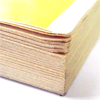|
|
|
|
|
|
|

| 최근 이 책을 구매하신 다른 회원의 책장 |
|
 |
|
|
|
[ 책 소개 ]
예술가가 어디에서 어떻게 영감을 얻는지를 보여주는 Caldecott 수상작가 Allen Say의 예사롭지 않은 그림책입니다.
동양계 소녀 엠마는 어려서 부터 그림에 놀라운 재능을 발휘하면서 상이란 상은 모조리 휩쓸어 버립니다. 사람들은 엠마의 그림에 나타나는 독창성과 모티브가 어디에서 나온 것인지 궁금해 합니다만, 엠마는 절대로 말을 하지 않습니다. 엠마는 태어날 때부터 옆에 있었던 조그만 크기의 하얀 색 양탄자를 애지중지합니다. 언제나 털이 볼슬복슬한 양탄자를 들여다보고 끊임없이 생각에 잠기곤 했지요. 사실은 양탄자가 엠마에게서는 텔리비젼과 같이 온갖 장면들을 떠올리게 했었죠. 어느날 엠마의 엄마는 양탄자를 그동안 한번도 빨지 않은 것을 깨닫고는 세탁기에 넣고 돌려 버렸습니다. 세탁이 된 양탄자는 깨끗했습니다만, 예전의 복실복실한 양탄자는 아니었죠. 엠마는 그날 이후 너무나도 낙담해서 모든 그림 도구와 양탄자를 쓰레기통에 버리고는 일체 그림을 그리지 않았습니다. 하지만 어느날 자기 방에 혼자 앉아 있었던 엠마는 등 뒤의 벽에 무엇인가가 날아가는 것을 보게 됩니다. 그리고 정원의 숲풀 속에서 개, 물고기, 박쥐, 게, 곰, 호랑이, 고양이, 그리고 자신의 얼굴과 같은 온갖 형상들을 볼 수 있게 됩니다...
큰 사이즈 | 닫기x |  What is 페이퍼백? What is 페이퍼백?
표지가 두꺼운 판지나 보드지가 아닌 비교적 얇은 종이를 사용해서 만든 책이며, 실박음질 대신에 풀로 제본처리하는 경우가 많습니다. 일반적으로 하드커버나 보드북에 비해서 가격이 저렴합니다. 소프트커버로 불리우기도 합니다. 책의 이음새 부분이 접히거나 휘는 내구성이 그리 좋지는 않은 책입니다.
|
[ 서지 정보 ]
Edition: Paperback: 32 pages
ISBN-10: 0618335234
ISBN-13: 978-0618335237
책 크기 : 28.5cm x 24.3cm
[ 영문 서평 ]
Annotation
A young artist finds that her creativity comes from within when the rug that she had always relied upon for inspiration is destroyed.
Book Description
Emma is a gifted young artist whose most prized possession is a small, shaggy rug. When her mother accidentally puts the rug in the washing machine and destroys it, Emma is devastated and ceases her art.
Publisher's Weekly
As a small child, Emma has two noteworthy practices: she stares for long periods at the fuzzy white rug she has had since birth, and she spends quite a bit of time drawing intently. When she enters school and garners many prizes for her artwork, it becomes clear that the seemingly blank rug is the source of her inspiration. Knowing more than Emma's mother, youngsters will wish they could intervene when she decides, soon after Emma is feted as the winner of a citywide art competition, that the now-dingy rug needs a washing and throws it into the machine. Caldecott Medalist Say's (Grandfather's Journey) deftly understated tale leaves ample room for readers' own interpretations. Yet it is his superb visual images, which have the semblance of faultlessly composed photographs, that make the most indelible mark here. As he has so affectingly accomplished with the characters in his previous works, Say fills Emma's face with abundant expression; her moments of anguish when she thinks she has lost the source of her art and her subsequent despondency seem wrenchingly real. Equally convincing is the child's tentative hopefulness when, in the book's most innovative picture, she spies the faces of many intriguing creatures (which Say hides playfully around her) begging to be drawn. An impressive creation, to be appreciated on many levels. All ages.
School Library Journal
Emma's small, plain white rug has been with her since her birth. What makes the child unusual, however, is not her love for her blanket, but her precocious artistry. In kindergarten her paintings amaze her teachers; in first grade she wins top prize in school, citywide, and other competitions. Emma is not impressed by her success: she "only looked at her rug." Comes the day when Mother puts the never-cleaned mat into the washer. It emerges ragged and thin. Emma is devastated and ceases to paint, days later disposing of all her work, awards, materialsand rug. Then, on the now-bare wall of her room, she seems to catch sight of something. Rushing outside, she recognizes the denizens of her imagination and artist's eye, creatures "she had thought she would never see again." On the last page, she is putting pencil to paper. Adults, certainly, will make the connection between the tabula rasa of Emma's rug and the projections of her imagination. Readers who do not see all the subtlety of this story may still be delighted by the watercolorsboth Emma's childlike ones and Say's luminous evocation of her world, exterior and interior (the picture of Emma's anguish at her rug's fate is wrenching). Even baseboards and floorboards are eloquent as Say paints them. A tale about nothing less than the coming-to-consciousness of an artist who, in her seventh year, already feels her very identity inextricable from the making of art.Patricia (Dooley) Lothrop Green, St. George's School, Newport, RI |
|
|
|
|
|
|
|
|